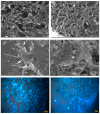Potential of Bioactive Glasses for Cardiac and Pulmonary Tissue Engineering
- PMID: 29244726
- PMCID: PMC5744364
- DOI: 10.3390/ma10121429
Potential of Bioactive Glasses for Cardiac and Pulmonary Tissue Engineering
Abstract
Repair and regeneration of disorders affecting cardiac and pulmonary tissues through tissue-engineering-based approaches is currently of particular interest. On this matter, different families of bioactive glasses (BGs) have recently been given much consideration with respect to treating refractory diseases of these tissues, such as myocardial infarction. The inherent properties of BGs, including their ability to bond to hard and soft tissues, to stimulate angiogenesis, and to elicit antimicrobial effects, along with their excellent biocompatibility, support these newly proposed strategies. Moreover, BGs can also act as a bioactive reinforcing phase to finely tune the mechanical properties of polymer-based constructs used to repair the damaged cardiac and pulmonary tissues. In the present study, we evaluated the potential of different forms of BGs, alone or in combination with other materials (e.g., polymers), in regards to repair and regenerate injured tissues of cardiac and pulmonary systems.
Keywords: angiogenesis; bioactive glasses; cardiac regeneration; lung tissue engineering; scaffold; soft tissue engineering.
Conflict of interest statement
The authors declare no conflict of interest.
Figures






References
-
- Galiè N., Humbert M., Vachiery J.-L., Gibbs S., Lang I., Torbicki A., Simonneau G., Peacock A., Vonk Noordegraaf A., Beghetti M., et al. 2015 ESC/ERS guidelines for the diagnosis and treatment of pulmonary hypertension: The joint task force for the diagnosis and treatment of pulmonary hypertension of the European Society of Cardiology (ESC) and the European Respiratory Society (ERS): Endorsed by: Association for European Paediatric and Congenital Cardiology (AEPC), International Society for Heart and Lung Transplantation (ISHLT) Eur. Heart J. 2015;37:67–119. - PubMed
-
- Levine D.J., Glanville A.R., Aboyoun C., Belperio J., Benden C., Berry G.J., Hachem R., Hayes D., Neil D., Reinsmoen N.L., et al. Antibody-mediated rejection of the lung: A consensus report of the International Society for Heart and Lung Transplantation. J. Heart Lung Transplant. 2016;35:397–406. doi: 10.1016/j.healun.2016.01.1223. - DOI - PubMed
Publication types
LinkOut - more resources
Full Text Sources
Other Literature Sources

